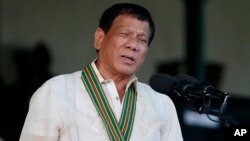Relations between China and the Philippines appear to be stabilizing after the Manila government backed away from a plan to militarize the disputed Spratly Islands in the South China Sea.
Philippine President Rodrigo Duterte, known for his flamboyant speeches and fast-changing plans, stated April 6 that he would order troops to the Spratly Islands, part of the South China Sea that Beijing also claims. He made the pledge after receiving criticism following media reports that said he knew Chinese vessels were exploring last year off the Philippine Pacific coast.
Since then, Duterte has said the Philippines will just improve structures on as many as nine Spratly islets currently under its control and he will not visit the island of Pag-asa in person to plant the national flag. He had previously said he might go there on Philippine independence day, June 12.
“He said he will go to Pag-asa to plant the flag,” said Jay Batongbacal, director of the Institute for Maritime Affairs and Law of the Sea at the University of the Philippines. “But by the second or third day, he was not mentioning that. He doesn’t talk about it anymore. He just stopped talking about it.”
Duterte recalibrates
Duterte’s recalibration over the Spratly Islands points to a continued focus on replacing the Philippines’ historic dependence on its former colonizer, the United States, with a more diverse foreign policy and pursuit of investment from China.
Regional analysts say China, which expressed “concern” last week, has let the earlier Spratly Island comments go.
“The Chinese side hopes the Philippine side will continue to work with the Chinese side to properly control maritime disputes and work together in maintaining the healthy development of Sino-Philippine relations,” spokeswoman Hua Chunying told a media briefing in Beijing April 7.
Another ministry spokesman said Thursday China was “happy to see the Philippines and China can further meet each other in halfway.”
Duterte visited China in October to mend relations strained by the South China Sea sovereignty dispute that landed in a world arbitration court. Also last year, Duterte cut off joint naval patrols with the United States, China’s chief worry at sea because of its military might.
“I don’t think Duterte needs to do any more to impress China,” said Eduardo Araral, an associate professor at the National University of Singapore’s public policy school. “What he has already done has won him in good stead with the Chinese.”
Court ruling
China has tried to get along with four Southeast Asian rival maritime claimants since the world court ruled in July against the legal basis cited by the Beijing government to explain its control of more than 90 percent of the sea. As part of that effort, it pledged $24 billion in aid and investment for the Philippines.
Beijing’s claims to the 3.5 million-square-kilometer sea, backed up increasingly by construction of artificial islands that in some cases are ready for deployment of combat aircraft and radar systems, has irritated Brunei, Malaysia, Taiwan and Vietnam as well as the Philippines.
Each government claims all or parts of the South China Sea. The tropical body of water extending from Taiwan to Singapore is known for fisheries, oil, gas and shipping lanes.
Sino-Philippine relations sank in 2012 because of a standoff at Scarborough Shoal, a fishery-rich feature in the South China Sea northwest of Manila. China still blocks Philippine fishing boats at the shoal.
The mid-March discovery that Duterte knew about Chinese vessels at Benham Rise, a sprawling, resource-rich undersea plateau of the Luzon Island Pacific Coast, rekindled Philippine distrust over China and raised questions about how cozy Duterte had become with leaders in Beijing.
Public pressure
China understands the public pressure on Duterte, said Yun Sun, senior associate with the East Asia Program under Washington-based think tank the Stimson Center.
“My impression is that the Chinese have a pretty high tolerance level for Duterte,” Sun said. “I think the Chinese also understand that Duterte also has a domestic constituency he has to answer to.”
Intent only to improve “living conditions” on the Spratly Islands should not make China “overly critical,” said Carl Baker, director of programs at the think tank Pacific Forum CSIS in Honolulu.
On Pag-asa, also called Thitu, small houses, guard posts and an airstrip support some 200 residents, largely fishermen, and 50 rotating soldiers. Local officials were discussing plans last year for a new seaport in the Spratlys.
“The justification Duterte is using to improve living conditions is the same as the other claimants have used to justify the upgrades to facilities on features they occupy,” Baker said.








